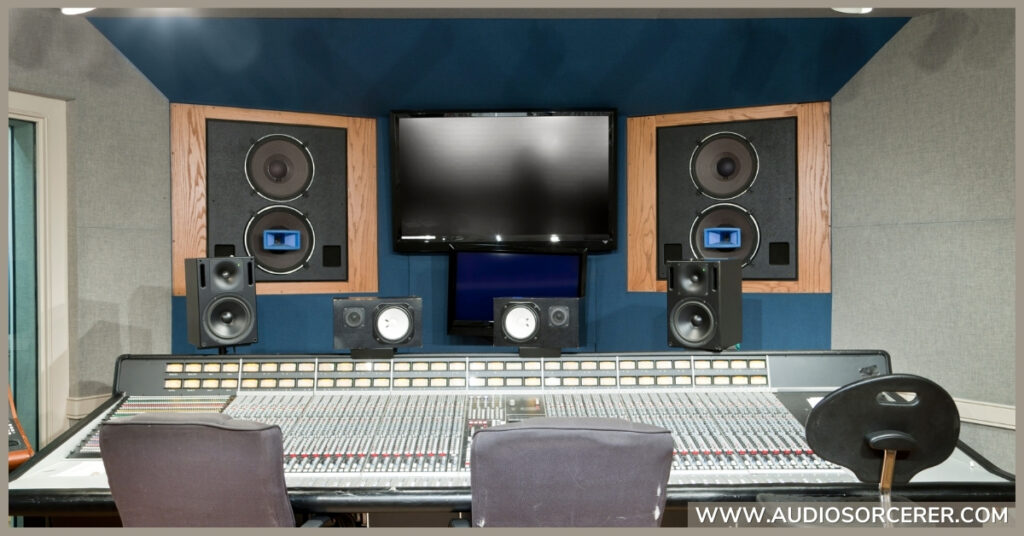
Ever wonder why those speakers in recording studios look so different? They're not just for listening to your favorite tunes! These special speakers, called studio monitors, help musicians, sound editors, and even video game designers make sure everything sounds perfect. There are two main types: near field and far field. Today, we'll explore each type so that you can understand why they look and sound so different!

Near field monitors are the compact workhorses of the audio production world. Imagine them as the magnifying glasses of sound, letting you zoom in on every detail. Typically sporting drivers between 5 and 8 inches, these monitors are meant to be positioned right up close, around 2-5 feet away from your ears.
Overall, near field monitors are excellent choices for detailed monitoring, smaller spaces, and budget-conscious setups. Just keep in mind their limitations, especially when dealing with bass-heavy content.
Related Article: The Top 5 Best Studio Monitor Stands Of 2024

Now, let's step back and meet the far field monitors, the giants of the studio world. These impressive speakers typically boast drivers ranging from 8 inches to 12 inches or even larger, designed to fill the room with sound. Unlike their near field counterparts, you'll find them positioned further away from your listening position, usually around 6-10 feet back.
Overall, far field monitors excel at delivering a full-range listening experience and are ideal for professional studios with treated rooms. However, their room dependence, higher cost, and space requirements make them less practical for everyone.
Now that we've explored the strengths and weaknesses of both near field and far field monitors, the big question remains: which one is right for you?
Near field monitors are a perfect fit for:
However, consider far field monitors if:
Remember, both types of monitors have their place. Many professional studios utilize a combination of both, using near fields for detailed work and far fields for final reference checks. Ultimately, the best choice depends on your specific needs, budget, and listening environment.
Related Article: The Top 5 Best Studio Monitor Controllers Of 2024
The main difference lies in how they interact with room acoustics. Near field monitors are designed for listening at close range to minimize room effects and provide accurate sound, ideal for critical listening and mixing in smaller spaces. Far field monitors are meant for larger spaces and intended to produce a broad sound stage that incorporates natural room reverberations, simulating a more real-world listening experience.
Absolutely! Many professional studios utilize both types of monitors. Near fields are often used for detailed mixing and editing tasks, while far fields provide a reference for how the mix translates in a larger listening space.
While room treatment is highly recommended for accurate monitoring with far field speakers, there are some basic acoustic treatments you can implement to improve your listening environment, such as using acoustic panels, bass traps, and diffusers. However, near field monitors might still be a better choice if treating your room is not feasible.
There are many excellent options available from various brands, and the best choice depends on your specific needs and budget. Some popular choices for near field monitors include Yamaha HS5, KRK Rokit 5 G4, and JBL 305P MkII. For far field monitors, Adam Audio S6X, Neumann KH 420, and ATC SCM150ASL are well-regarded options.
While headphones can be useful for referencing and checking specific details, they are not ideal for primary monitoring due to their limited soundstage and frequency response. Monitors provide a more accurate representation of how your music will sound in different listening environments.
After exploring near field vs far field monitors throughout this article, you should now have a good idea which one is right for you. Remember, there's no one-size-fits-all solution, and the best choice depends on your specific needs and setup. So, go forth, explore, and find the perfect sonic partner to bring your creative vision to life!
If you found this guide helpful, please consider subscribing to our blog for more music production tips, product reviews, and buying guides. Also, you can support new content by contributing to our tip jar.
"Some of the links within this article are affiliate links. These links are from various companies such as Amazon. This means if you click on any of these links and purchase the item or service, I will receive an affiliate commission. This is at no cost to you and the money gets invested back into Audio Sorcerer LLC."